Shepard Point, Alaska –
When the Exxon Valdez grounded on Bligh Reef in Prince William Sound on March 24, 1989, more than 11 million gallons of heavy crude oil spilled into the sound. The spill spread over a vast area, impacting around 1,300 miles of coastline. Response efforts did not arrive onsite until 14 hours after the spill, and it took another 21 hours to place booms around the oil.
The incident prompted changes in oil spill prevention, response regulations and practices. It led to the passage of the Oil Pollution Act of 1990 in the United States, spurred advancements in spill response technology and techniques and helped pass the Alyeska Consent Decree, which mandated the construction of three oil response facilities around the Prince William Sound: Chenega, Tatitlek, and Cordova. Of the three facilities, Cordova is the last to be built.
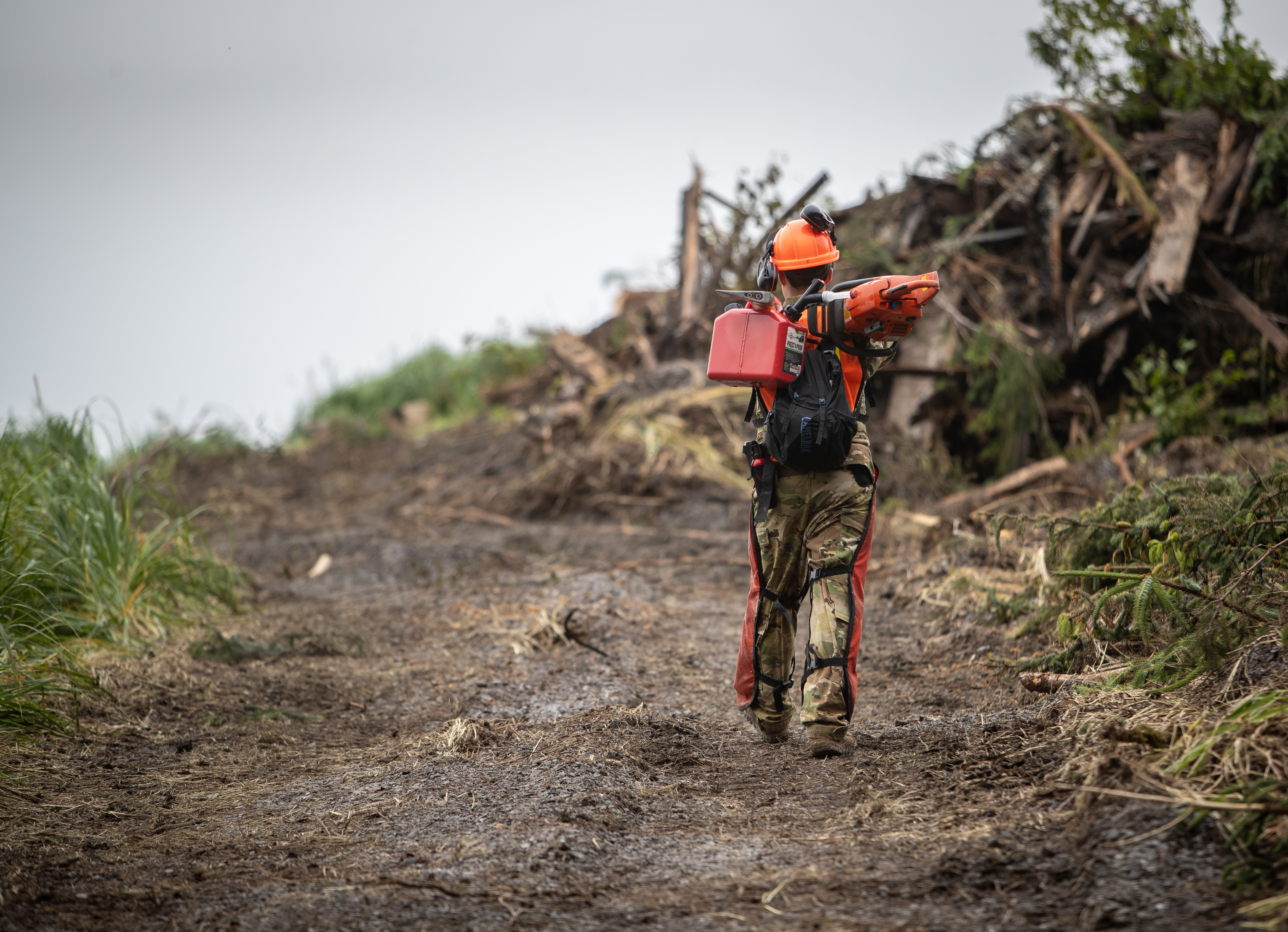 Alaska Air National Guard Staff Sgt. Brenden Turney, a fire protection craftsman from the 176th Civil Engineer Squadron, carries his gear at Shepard Point, near Cordova, during an Innovative Readiness Training project, July 26, 2023. The Guardsmen are clearing a 5.5-acre site for the Shepard Point Marine Tribal Transportation Oil Spill & Marine Casualty Response Facility. (Alaska National Guard photo by Robert DeBerry)
Alaska Air National Guard Staff Sgt. Brenden Turney, a fire protection craftsman from the 176th Civil Engineer Squadron, carries his gear at Shepard Point, near Cordova, during an Innovative Readiness Training project, July 26, 2023. The Guardsmen are clearing a 5.5-acre site for the Shepard Point Marine Tribal Transportation Oil Spill & Marine Casualty Response Facility. (Alaska National Guard photo by Robert DeBerry)
More than three decades later, construction on the Shepard Point Marine Tribal Transportation Oil Spill & Marine Casualty Response Facility is set to begin. The Native Village of Eyak has taken the lead on the project with partial funding coming from a $45.7 million federal transportation grant with some in-kind donation from the Department of Defense Innovative Readiness Training (IRT) program.
For Chief Master Sgt. Mike Keegan, senior enlisted leader of the 176th Civil Engineering Squadron, Alaska Air National Guard, DoD’s involvement through the IRT program is a training opportunity they would not normally have. While he has been involved with numerous IRT projects in past years, he is particularly proud to have his unit lead off the first phase of this community-focused project.
“This one has a good feel to it. To be the first one on the ground to kick it off means a lot,” he said.
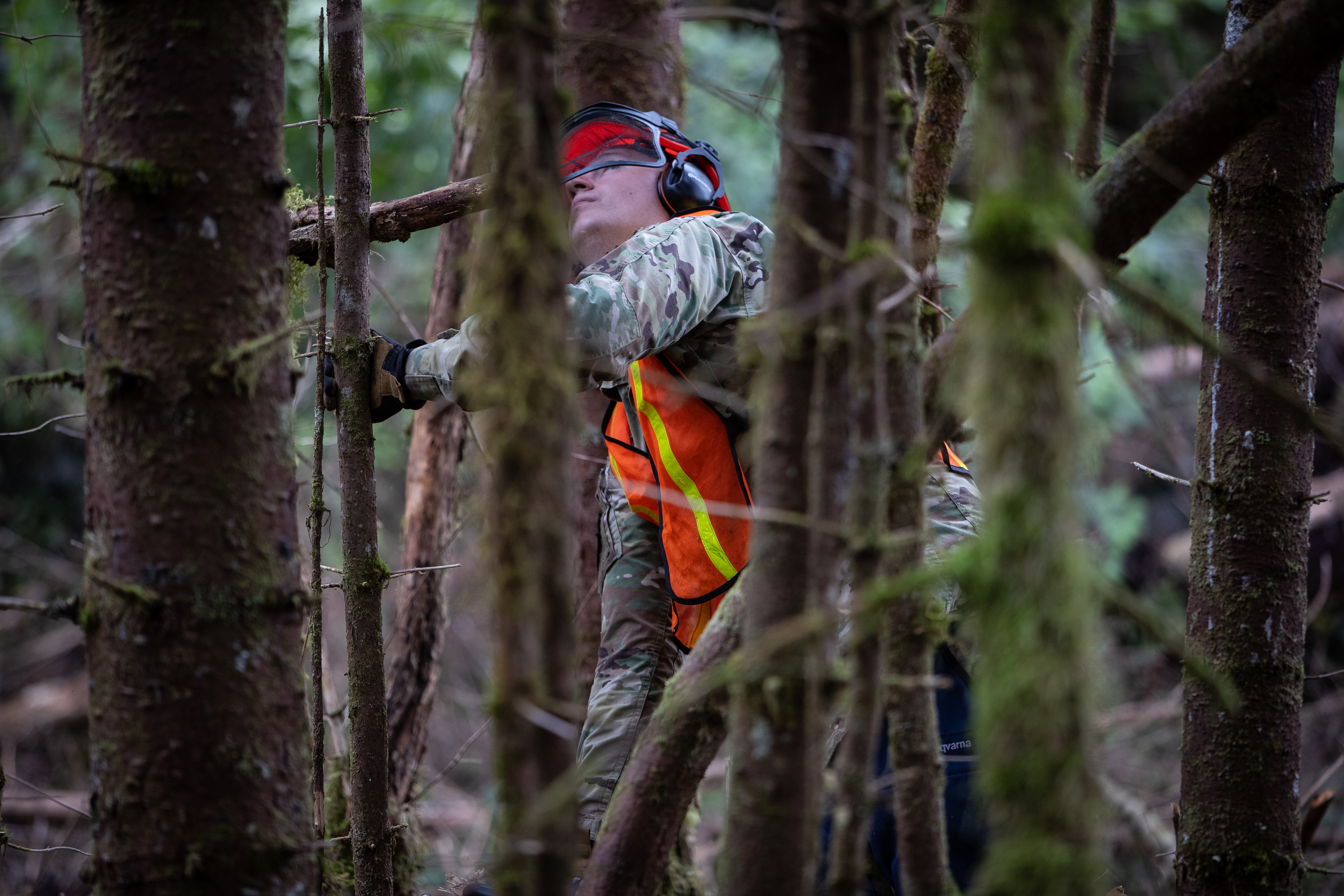 Alaska Air National Guard Airman John Godfrey, a heating ventilation air conditioning and refrigeration apprentice from the 176th Civil Engineer Squadron, clears smaller trees before felling larger ones at an Innovative Readiness Training site at Shepard Point, near Cordova, July 26, 2023. Twelve Guardsmen are clearing a 5.5-acre site for the Shepard Point Marine Tribal Transportation Oil Spill & Marine Casualty Response Facility. The IRT program is an initiative of the U.S. Department of Defense that leverages the skills and capabilities of military personnel to support civil-military cooperation, humanitarian missions, and community development. (Alaska National Guard photo by Robert DeBerry)
Alaska Air National Guard Airman John Godfrey, a heating ventilation air conditioning and refrigeration apprentice from the 176th Civil Engineer Squadron, clears smaller trees before felling larger ones at an Innovative Readiness Training site at Shepard Point, near Cordova, July 26, 2023. Twelve Guardsmen are clearing a 5.5-acre site for the Shepard Point Marine Tribal Transportation Oil Spill & Marine Casualty Response Facility. The IRT program is an initiative of the U.S. Department of Defense that leverages the skills and capabilities of military personnel to support civil-military cooperation, humanitarian missions, and community development. (Alaska National Guard photo by Robert DeBerry)
Keegan said the Guard brings a lot of value to the project from the military aircraft used to transport the 13-person team, the amount of time working, and the equipment being used, all of which contribute significantly to the project's efficiency and success.
During the unit’s two-week annual training, the Guardsmen from Joint Base Elmendorf Richardson will use everything from large excavation machines and skid steers to chain saws and hand tools to clear a 5.5-acre staging area near the oil spill response site for equipment and building materials.
Keegan said the deep-water port project meets key domestic operations training objectives and gives his team some real-world skills in the event of an emergency.
“We’re getting two solid weeks of hands-on experience felling trees, pulling stumps and stacking logs,” he said. “In the event of an emergency, we will have some skilled people ready to respond.”
“We may just be clearing five acres, but it adds another $800,000 or $1 million to the project in the form of a grant, so we’re pretty excited to be able to help,” he said.
Alaska Air National Guard Technical Sgt. Paul Carter, a power production craftsman from the 176th Civil Engineer Squadron, performs land clearing operations at Shepard Point, near Cordova, during an Innovative Readiness Training project, July 26, 2023. (Alaska National Guard photo by Robert DeBerry)
Senior Master Sgt. Blake Varnell with the 176th CES said for the team on the ground the training provides the opportunities they would not normally get.
“On the civil engineers front I’ve got plumbers and I’ve got HVAC out here. I’ve got all these different career fields and this project is more of a vertical structures type of career field,” said Varnell as he prepared to stack trees using a large excavator. “These IRT projects are a game changer for the Guard. It’s not often we get to do this type of training.”
Maj. Timothy Golden with the AKARNG 208th Construction Management Team said projects like this bring a couple different opportunities to the Guard.
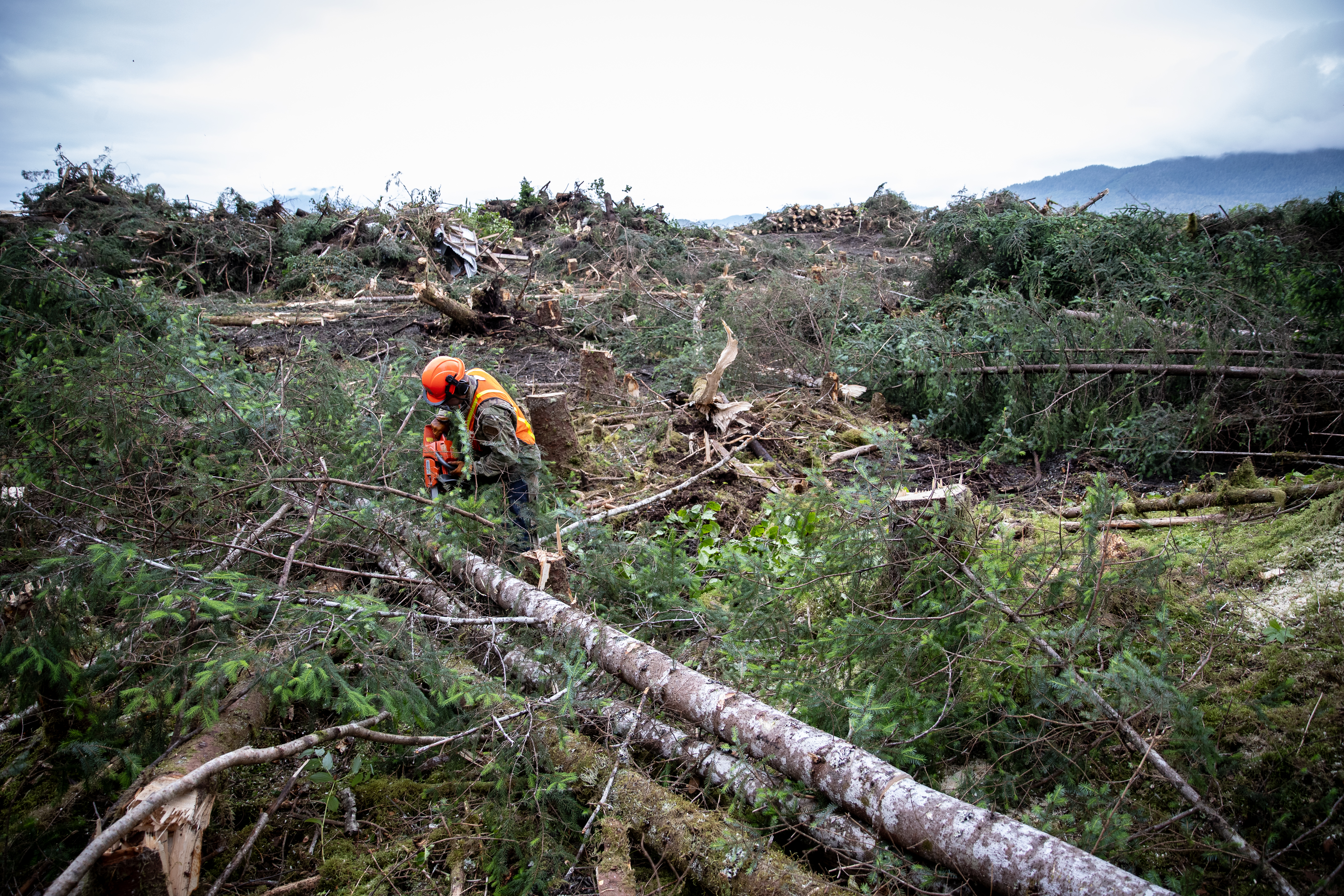 Alaska Air National Guard Staff Sgt. Brenden Turney, a fire protection craftsman from the 176th Civil Engineer Squadron, delimbs a tree as part of an Innovative Readiness Training project at Shepard Point, near Cordova, July 26, 2023. (Alaska National Guard photo by Robert DeBerry)
Alaska Air National Guard Staff Sgt. Brenden Turney, a fire protection craftsman from the 176th Civil Engineer Squadron, delimbs a tree as part of an Innovative Readiness Training project at Shepard Point, near Cordova, July 26, 2023. (Alaska National Guard photo by Robert DeBerry)
He said getting the hands-on training while having to simultaneously overcoming the various logistical challenges and complex operating environment allowed the team members to build new skills and gain the confidence to tackle these complex tasks.
“Secondly, it’s been great opportunity for our joint capability,” he said. “We worked with the Air Force, the Coast Guard and originally, this was a Navy project, so there has been a lot of joint opportunities.”
He said projects like Shepard Point provide training value as well as positive community engagement which really is the core of the IRT program.
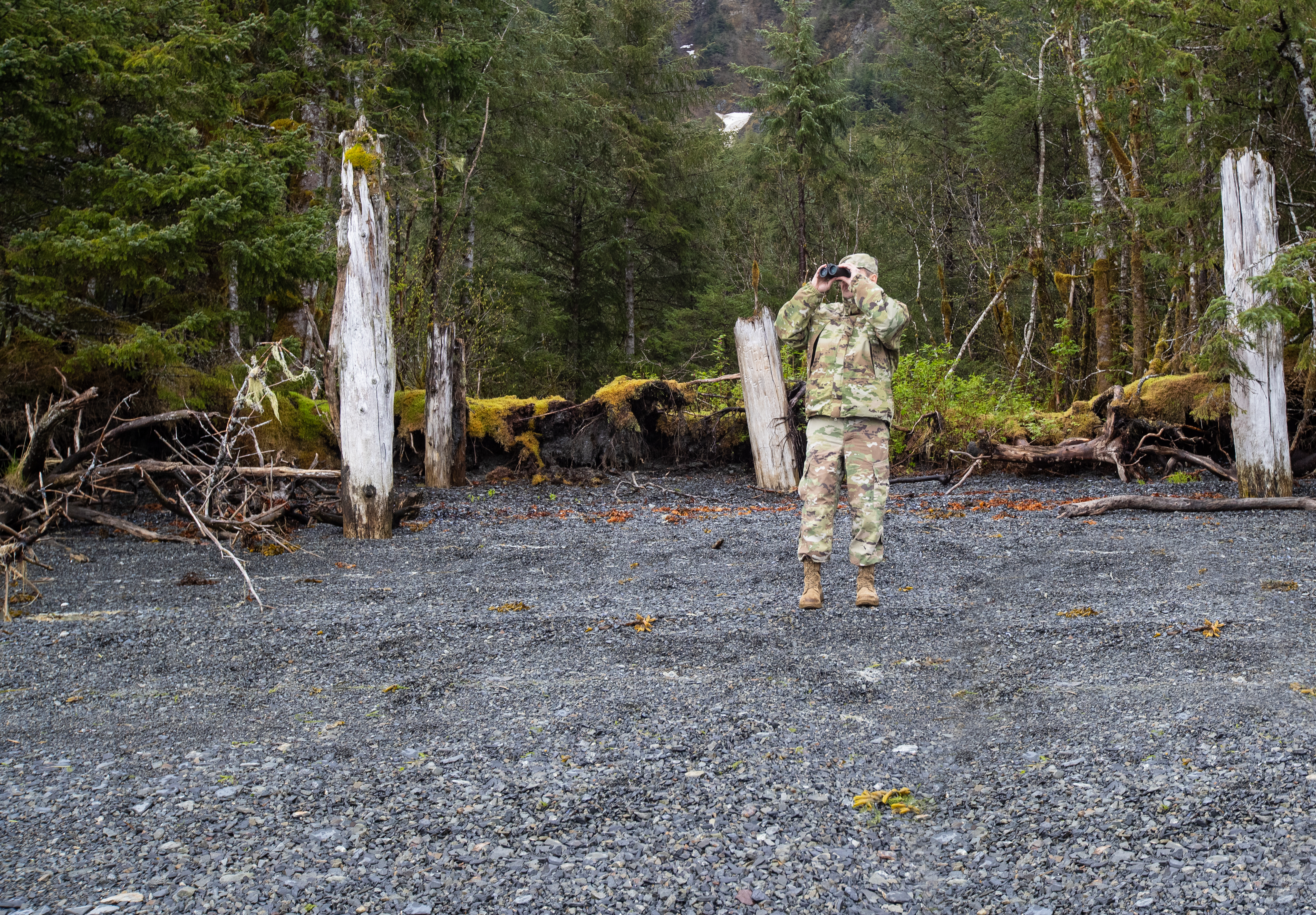 Col. George Koklanaris, deputy director, Civil-Military Engagement, IRT Program, looks through binoculars while touring the Shepard Point oil spill response site near Cordova May 25, 2023. (Alaska National Guard photo by Robert DeBerry)
Col. George Koklanaris, deputy director, Civil-Military Engagement, IRT Program, looks through binoculars while touring the Shepard Point oil spill response site near Cordova May 25, 2023. (Alaska National Guard photo by Robert DeBerry)
The IRT program is an initiative of the U.S. Department of Defense that leverages the skills and capabilities of military personnel to support civil-military cooperation, humanitarian missions, and community development.
Through the IRT program, military units, including the National Guard and Reserve components, collaborate with federal, state, tribal, and local government entities, as well as nonprofit organizations and community leaders. Together, they identify and prioritize projects that align with military training objectives while addressing specific community needs.
According to Col. George Koklanaris, deputy director, Civil-Military Engagement, IRT Program, the Shepard Point project will provide a great training opportunity for the 176th CES.
“Our piece of the project is pretty solid,” said Koklanaris as he toured the site nearly five miles outside Cordova. “I’ve been involved with this for a couple years. It is a lot of engineering and construction and from a training standpoint we will get some good training here for the Alaska National Guard.”
Items found during land clearing by 176th Civil Engineer Squadron and 176th Medical Group at Shepard Point near Cordova, Alaska, July 26, 2023. As part of an Innovative Readiness Training program the guardsmen are clearing a 5.5-acre site for the Shepard Point Marine Tribal Transportation Oil Spill & Marine Casualty Response Facility. (Alaska National Guard photo by Robert DeBerry)
The IRT Coordinator for the Alaska National Guard, Maj. James Goddard, said the Shepard Point project is a “win, win” for the Guard and the community.
He said the National Guard IRT Training program will bring significant benefits to Shepard Point by providing enhanced training, collaboration opportunities, community engagement, and valuable insight, which is beneficial for both the Guard and the community.
“With our two weeks of annual training, the 176th civil engineers are going to use their training dollars to do this project, which is in our backyard. The C-17s and Chinooks are going to do this in our backyards. They are all using their training dollars,” said Goddard. “The Alaska National Guard gets the training, and the community gets help with a large project.”
 Clouds partially obscure the mountains surrounding Shepard Point near Cordova, Alaska, July 26, 2023. Shepard Point is the site of an Innovative Readiness Training program. As part of the IRT program, the 176th CES are clearing a 5.5-acre site for the Shepard Point Marine Tribal Transportation Oil Spill & Marine Casualty Response Facility. (Alaska National Guard photo by Robert DeBerry)
Clouds partially obscure the mountains surrounding Shepard Point near Cordova, Alaska, July 26, 2023. Shepard Point is the site of an Innovative Readiness Training program. As part of the IRT program, the 176th CES are clearing a 5.5-acre site for the Shepard Point Marine Tribal Transportation Oil Spill & Marine Casualty Response Facility. (Alaska National Guard photo by Robert DeBerry)
Goddard said the spill response center has an additional benefit to the military and the state of Alaska in the event of a large-scale disaster. If the Anchorage-area airports became unusable, Cordova’s all-weather air strip can be used fly in equipment and supplies. Those supplies can be loaded onto boats at the oil response deep-water port and then transported to Whittier for further transport to Anchorage.
The IRT portion of the project is fairly small compared to the overall project, but it is also the first step in getting dirt turned and the project started. Construction was set to begin in early 2022 but funding, permitting and right-of-way acquisition took longer than expected.
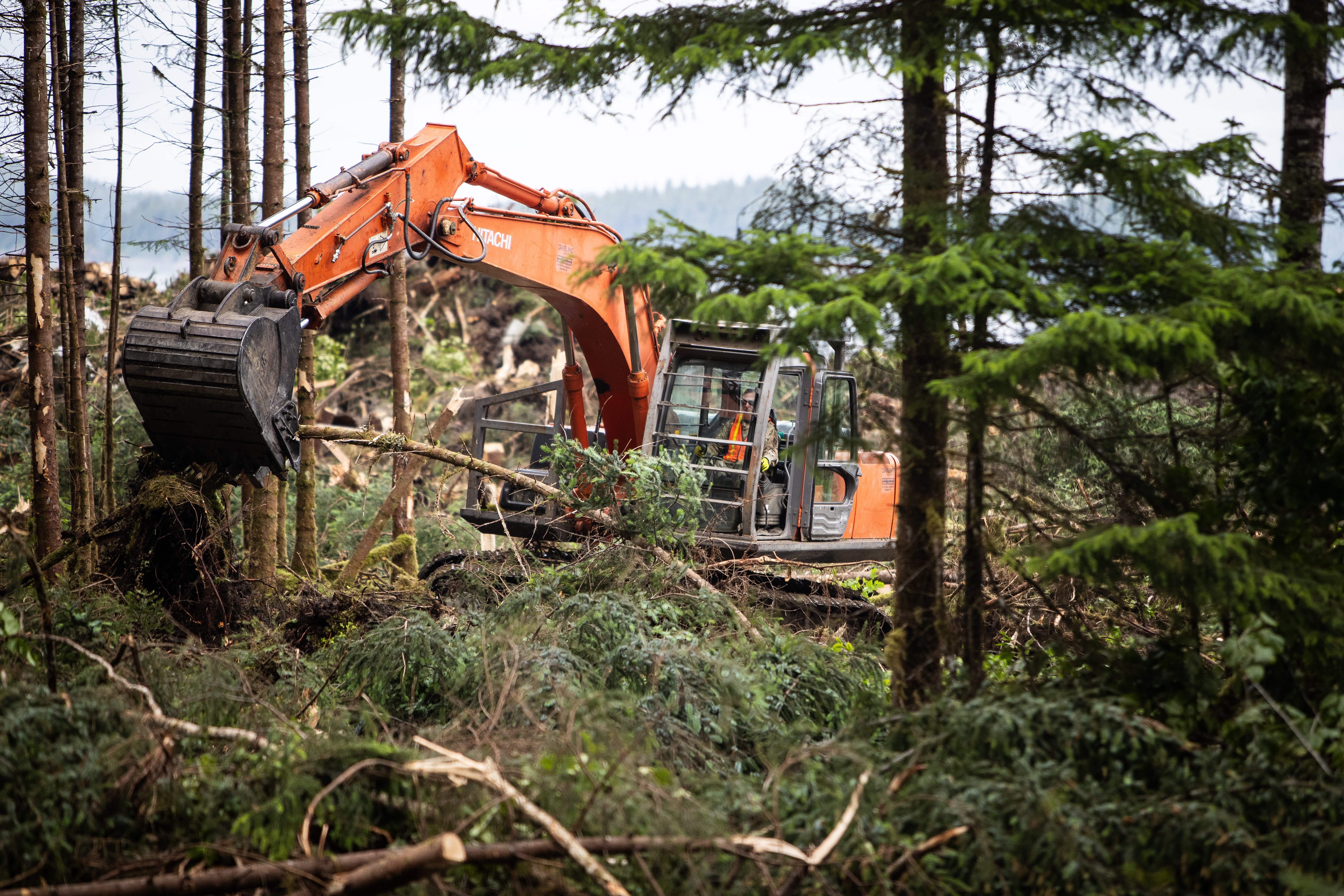 Alaska Air National Guard Senior Master Sgt. Blake Varnell, a facilities manager with the 176th Civil Engineer Squadron, uses an excavator to clear land at Shepard Point, near Cordova, during an Innovative Readiness Training project, July 26, 2023. Twelve Guardsmen are clearing a 5.5-acre site for the Shepard Point Marine Tribal Transportation Oil Spill & Marine Casualty Response Facility. (Alaska National Guard photo by Robert DeBerry)
Alaska Air National Guard Senior Master Sgt. Blake Varnell, a facilities manager with the 176th Civil Engineer Squadron, uses an excavator to clear land at Shepard Point, near Cordova, during an Innovative Readiness Training project, July 26, 2023. Twelve Guardsmen are clearing a 5.5-acre site for the Shepard Point Marine Tribal Transportation Oil Spill & Marine Casualty Response Facility. (Alaska National Guard photo by Robert DeBerry)
“This site was to be constructed quite some time ago when the oil spill took place,” said Kraig Hughes, senior structural and civil engineer with Bristol Engineering Services Company. It’s just taken so long with permitting and funding that now we are finally ready to go.”
Hughes said with Cordova having a small boat harbor there is the capability to respond right now to an oil spill, but the response capabilities are going to be limited. He said having a deep-water dock and dedicated space makes it more appealing for larger operations to lease space. Combined with the fact this is the only response site that has a direct connection with an all-weather airport gives this site an “immediate advantage.”
“We are in negotiations with some large oil spill response companies right now,” said Hughes. “Leasing the space will make the project more viable.”
There will be a 364-foot-long deep water, all-tide dock, uplands facilities, and a 4.32-mile access road connecting the facility to the all-weather Merle K. (Mudhole) Smith Airport in Cordova, which is a critical factor when it comes to transporting essential materials and personnel in the event of an incident. A wharf, mooring dolphins and trestle extending the dock to 635-foot long. A small boat launch and z-shaped interlocking steel sheet pile sea wall.
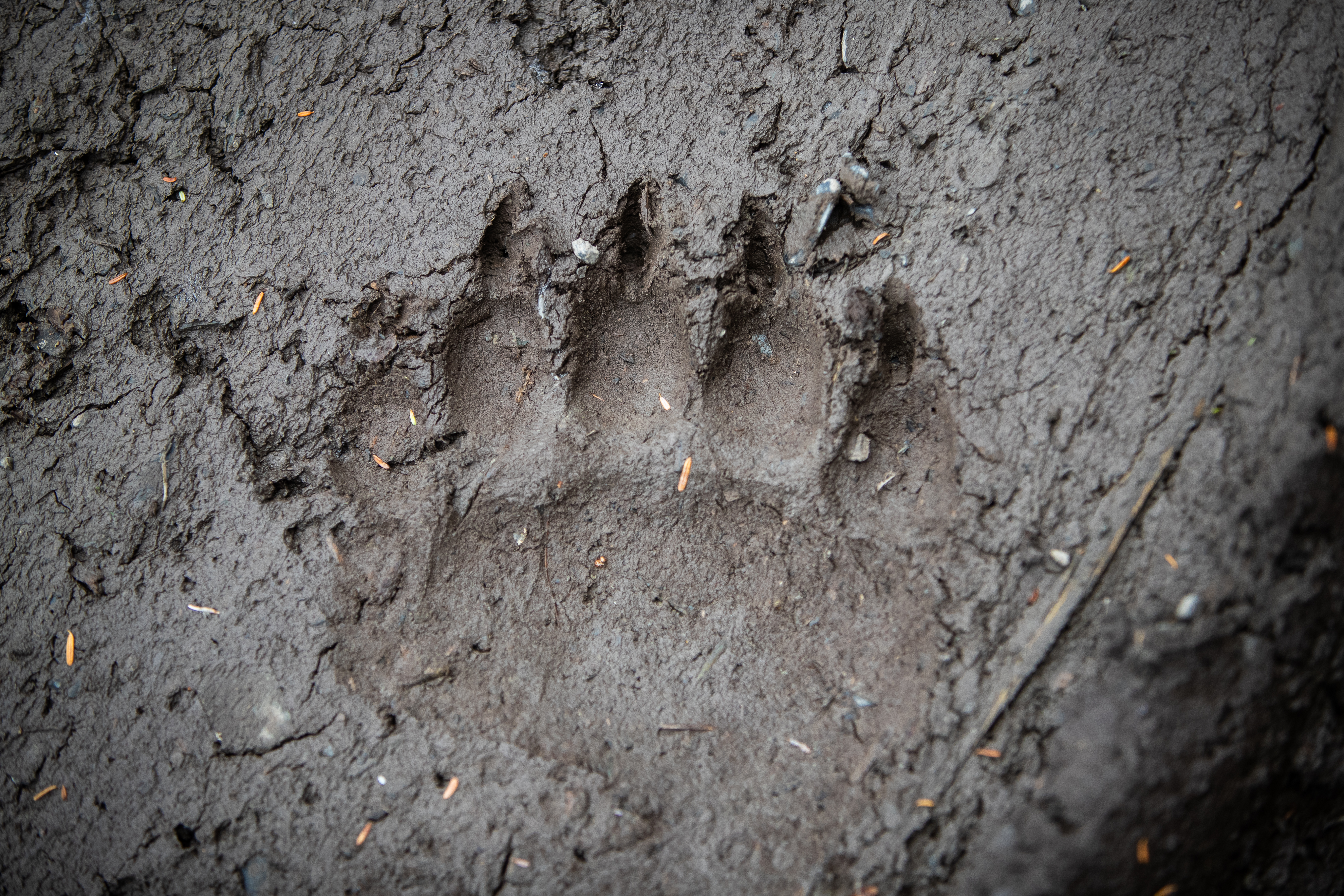 A bear track is visible in the mud at Shepard Point, near Cordova, where176th Civil Engineer Squadron and 176th Medical Group are participating in an Innovative Readiness Training project, July 26, 2023. Twelve Guardsmen are clearing a 5.5-acre site for the Shepard Point Marine Tribal Transportation Oil Spill & Marine Casualty Response Facility. (Alaska National Guard photo by Robert DeBerry)
A bear track is visible in the mud at Shepard Point, near Cordova, where176th Civil Engineer Squadron and 176th Medical Group are participating in an Innovative Readiness Training project, July 26, 2023. Twelve Guardsmen are clearing a 5.5-acre site for the Shepard Point Marine Tribal Transportation Oil Spill & Marine Casualty Response Facility. (Alaska National Guard photo by Robert DeBerry)
Goddard said the building and completion of this third and final site serves as a reminder of the importance of environmental stewardship, oil spill prevention, and effective response measures to mitigate the impact of such incidents on ecosystems and communities.
“Having the Alaska National Guard and the IRT program as a part of the process helps build trust, foster positive relationships, and facilitate a strong connection between the Guard and the local community,” he said.